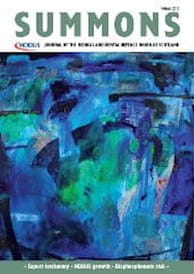DOUGLAS ALLAN HAS A particular memory of Dr Henry Noble – in the dusty wilderness of the Jordanian desert, perched precariously on a pile of cushions in the boot of a car facing to the rear with map in hand, guiding a site-seeing tour back to Yarmouk University in the northern town of Irbid.
It was an unorthodox way to travel for such an accomplished scholar, but Noble was known for his hands-on, down-to-earth approach. Professor Allan recalled meeting the Glasgow dental lecturer during a stay in Jordan in the 1980s – one of Noble’s many international expeditions to teach dentistry. In Yarmouk he helped establish a new dental school, training staff and delivering lectures in anatomy and histology.
Other trips took Henry Noble to the University of the West Indies in Trinidad in 1991 and he was also appointed external examiner at the University of Malaya, Kuala Lumpur. His dedication to his field never stopped wherever in the world he was – even on his many caravan trips to Portugal or Austria with his wife of 50 years, Audrey. Work colleagues could always depend on Noble to respond almost immediately to their emails.
Henry William Noble was born in Glasgow, 1925, and attended Dunoon Grammar School as a war-time evacuee. His passion for dental education began when he started studying dentistry in Glasgow in 1942. His year was the last of the ‘diploma dentists’ to qualify before Glasgow University took over the granting of degrees in 1948. As a house surgeon in Glasgow Dental Hospital, he also undertook teaching duties as a demonstrator in pathology and dental bacteriology and subsequently in dental histology. This field was to become his life’s work.
With the exception of two years’ national service in the RAF, Henry served Glasgow University as lecturer and then senior lecturer in dental anatomy and histology for 36 years. He was awarded the HDD of the RFPSG in 1948 (the predecessor of the Fellowship); obtained a fellowship in dental surgery from the Royal College of Physicians and Surgeons of Glasgow in 1967; and became a Fellow of the British Association of Clinical Anatomists in 1978. Henry also found time to serve as president of Glasgow Odontological Society in 1972 where he was editor for years before becoming an honorary member in 2002.
Noble was a born teacher. He would enthral students with his dramatic lecturing style that always incorporated the latest methods and embraced the newest technology. Lessons were never dull as Noble often punctuated them with group microscopy, audio-visual presentations or computerised instruction. For many years he organised the student electives. Never one for self-publicity, he applied a boundless energy and unstinting enthusiasm in guiding generations of young dentists through the early stages of their career.
Even retirement didn’t stop Henry from breaking new ground. He founded the History of Dentistry Research Group at Glasgow University in 1996. It flourished under his leadership and remains one of the largest and most active in the field. Henry contributed many articles to its newsletter and its members have also produced articles and doctoral theses – many written with the benefit of Henry’s vast knowledge and support.
It was Henry’s dedicated work in the field of dental history that earned him the coveted Tomes Medal in 2003 from the British Dental Association. He had done remarkable work helping with the redevelopment of the BDA Museum, often answering some of the many enquiries the museum received. The following year he was told he would receive a second accolade from the Lindsay Society for the History of Dentistry in the form of the Lillian Lindsay Memorial Medal. While Henry knew of his impending award, he sadly did not live long enough to accept it personally. His wife Audrey has since become secretary of the History of Dentistry Research Group, continuing the Noble family’s dedicated work.
The Emeritus Professor Stanley Gelbier paid tribute to Henry following his death, remarking: “His breadth and depth of knowledge were amazing. I cannot remember asking Henry any question that he was unable to answer. It is no surprise that Henry’s advice was always sought by the Museum of the British Dental Association when it was unable to respond to a query.”
Henry was highly regarded for his academic achievements, but above all he was known as a true gentleman who never knew how to do things by half-measures. His enthusiasm and commitment to the study of dentistry has earned him his own place in the history of dentistry. He was much loved by his wife Audrey, their four children and 10 grandchildren.
Professor Sir David Mason perhaps summed it up in his tribute when he said: “The example of his life and work will live on in the hearts and minds of those of us who were privileged to know him as a friend and colleague.”
Source: History of Dentistry Research Group Newsletter (November 2004)
This page was correct at the time of publication. Any guidance is intended as general guidance for members only. If you are a member and need specific advice relating to your own circumstances, please contact one of our advisers.
Read more from this issue of Insight

Save this article
Save this article to a list of favourite articles which members can access in their account.
Save to library